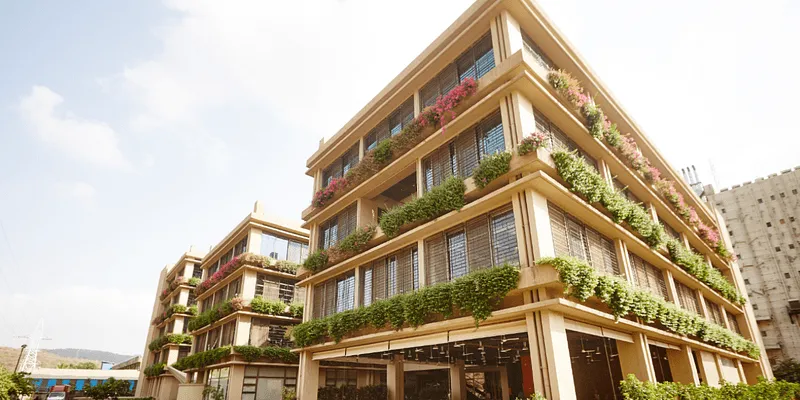From 2 sewing machines to Rs 800 Cr business: How Anita Dongre built her fashion empire
After enduring years of struggle and hardships, Anita Dongre’s fashion business, House of Anita Dongre, plays in the major leagues now. Renowned for its ‘AND’ fashion brand, the business has grown from two sewing machines to employing over 2,700 people directly, and thousands more indirectly.
The women in Anita Dongre’s Sindhi family all played stereotypical roles of wives and mothers. None of them worked jobs or started their own ventures.
Her mother, Pushpa Sawlani, used to stitch clothes for Anita and her siblings, and it was this that got young Anita interested in fabrics and fashion.
Growing up in Mumbai, she started noticing women who had corporate careers or were entrepreneurs. And while this inspired her, it also made her realise that there was no Indian brand that made affordable workwear for them.
This spelled an opportunity for Anita: she wanted to take her interest in fashion and turn it into a clothing brand for the modern, working woman.
“I started my business in 1995 with just two sewing machines and a loan from my father. My sister and I would work out of a small, 300 square foot area and make western outfits for women,” she tells SMBStory in an exclusive interview.

Anita Dongre, Chief Creative Officer, House of Anita Dongre
However, fashion stores and retail outfits rejected her designs, and mall owners refused to give her space to set up a shop. This, however, didn’t deter the headstrong youngster.
“I got so angry that I decided to start my own brand and do it myself,” she says.
This was the beginning of Mumbai-based ‘AND’ Designs, which, in 2015, became the House of Anita Dongre. Today, it is a venture that has a multi-dimensional portfolio with brands such as AND, Global Desi, Anita Dongre Bridal Couture, Anita Dongre Grassroot, and Anita Dongre Pink City.
After enduring years of struggle and hardships, Anita’s brainchild is now a successful fashion house, which currently employs over 2,700 people directly and thousands more indirectly, including artisans in rural villages across India.
Its retail turnover was Rs 800 crore in 2019-20, she says.
In an exclusive interaction with SMBStory, Anita, Chief Creative Officer at House of Anita Dongre, explains her recipe for success:
SMBStory [SMBS]: What is the business model? What are some of your unique business strategies?
Anita Dongre [AD]: House of Anita Dongre’s headquarters in Navi Mumbai is a one lakh square feet space that optimises the use of natural light, recycles and minimises the use of water, and reduces electricity consumption.

House of Anita Dongre headquarters in Navi Mumbai
My business’ foundations lie in my entrepreneurial pursuit that grew into a family-run business. Our corporate model is built on efficiency with the focus to achieve scale. This is particularly important when the work done is often the single source of income for men and women far out in India’s villages and its cities.
At the end of the day, this is a business built on the foundation of creating fashion for good. And, we have always wanted to be equipped with the right advice, talent, and thought leadership to make that happen.
Our manufacturing happens out of our headquarters in Navi Mumbai, with smaller partners, and in villages across India.
SMBS: What is the USP of your products and brands?
AD: Our Anita Dongre Wedding collection of clothes and jewellery for bridal couples and families is inspired by Indian traditions, but is lightweight and elegant. The label houses couture and pret for men and women, along with a selection of fine jewellery inspired by traditional Rajasthani craftsmanship.
AND offers a chic collection of western wear that combines formal and evening wear. We have evolved this brand to keep pace with our customers’ changing lifestyles. The label refreshes its designs and experiments with international trends to help customers create their own style.
Our Global Desi label is an India-inspired, young, colourful, boho-chic brand with a global appeal. Under the aegis of The Anita Dongre Foundation's women empowerment initiative, we set up community tailoring units in rural Maharashtra for Global Desi's production. Here, marginalised and needy tribal women are trained professionally to make garments.

An AND Fashion product shoot
The Grassroot label was born out of the need to revive and sustain Indian handcrafted traditions. We translate these heirloom crafts into contemporary, sustainable fashion. For this label, we have collaborated with a network of NGOs and independent craftspeople to provide artisans a consistent source of income and appreciation, by empowering them to create better livelihoods.
SMBS: How are you using digital platforms to reach your audience?
AD: House of Anita Dongre caters to the modern Indian woman. Each of our brands cater to a different life stage in her evolution. Digital platforms have been a disruptor for all businesses, and the House of Anita Dongre has taken a multipronged approach to this.
We make a conscious effort across social media verticals and our websites that accept global orders. We are currently in the process of bridging the gap between the online and offline experience, creating an omni channel approach to shopping, and engaging with each brand. This includes a fully-operational website.
SMBS: What have been some of the toughest moments in the company’s journey till now? ?
AD: Some examples that come to my mind are, in 2016, when Kate Middleton wore an Anita Dongre dress, the brand received so many requests that its website crashed.
The operations team set up dedicated production channels, almost overnight, to produce this dress, and meet the sudden influx of orders without delaying the others.
Another example comes from the challenge to constantly make our fashion a force of good. To solve the employment issue in the villages of Maharashtra, the team at Anita Dongre Foundation had to work with production teams to build a scalable plan to ensure women were given a respectable means of income in their village. We had to build a training module and mobilise resources to ensure almost 200 unskilled women could make garments.

House of Anita Dongre's community tailoring centre
SMBS: What are your future plans for the company?
AD: Right now everybody else is competition, but the fact of the matter is that in the fashion business, each person expresses their aesthetic, differently. At House of Anita Dongre, each brand was built to serve a purpose and constantly evolve with its customers.
A part of this vision is to expand our global footprint and bring Indian craftsmanship the spotlight it deserves on the global stage. We also want to continue our work in building economies through financially empowering women in India’s villages. The goal is to take learnings from five villages and go even further and reach more women.
SMBS: How has the current COVID-19 situation affected business, and what is being done to address this?
AD: This global pandemic is probably amongst the hardest challenges we have ever faced. Keeping people safe remains a priority in these trying times. Our employees are either working from home, or have been granted paid time off indefinitely, while the situation evolves. We started the production of masks after receiving permission from the concerned authorities in two of the five village centres we have in Maharashtra.
Right now, the focus is on keeping people safe and making sure that our smaller partners and vendors, including self-employed women artisans in villages, have access to a medical fund created specifically to alleviate worries about unforeseen medical expenses.
Our Rs 1.5 crore fund covers small vendors and self-employed artisans, while employees continue to be covered under the company’s robust corporate health insurance programme.
Business, however, has been affected. All stores are closed, and the expectation is of a slow recovery with reserved consumer sentiment. However, we are optimistic that post the pandemic, Indian consumers will choose more local products.
(Edited by Aparajita Saxena)










